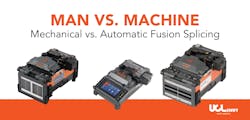Mechanical vs. Fusion Splicing: Which Is More Effective?
When it comes to ensuring that your fiber network can provide superior performance, utilizing fusion splicing offers many distinct advantages over mechanical splicing.
Fusion splicing consists of aligning and permanently fusing together stripped, cleaned, and cleaved optical fibers with a high-temperature arc. Mechanical splicing utilizes an alignment device and index matching gel that has a similar refractive index and covers the possible air gaps, helping light travel from one fiber to another. Because mechanical splicing simply "holds" the spliced fiber ends together, the typical insertion loss can be higher than a fusion splice, which provides a continuous connection between two fibers. From splice-on connectors to pigtails, or installation and/or repair for direct cable-to-cable splicing, fusion splicing provides an overall better performance and better protection from signal failure.
As mentioned, fusion splice losses are typically lower and are not subject to environmental limitations that mechanical splices suffer from. They provide a fast, reliable, low-loss connection with the lowest loss (in the range of 0.01 dB to 0.10 dB for single-mode fibers) and are practically non-reflective. While fusion splicing does offer the most benefits for performance, their ability to offer this performance in a variety of environmental settings is what makes them so versatile and a must-have for fiber network installs.
Typically, fusion splicers are used in the field or within a lab or OEM environment. While many splicers may be used in either environment, some splicers are designed for specific performance environments. When choosing the right fusion splicer for a particular application, it is important to take into consideration some of the following aspects:
- Loss Requirements: Determine the loss requirement of the application. Active core alignment splicers provide more precise and lower loss results than passive alignment systems.
- In general, active alignment units are more expensive; however, they typically provide lower splice loss and can be used wherever a passive alignment unit can. It is important to determine what application will be most often used and match those needs to the right fusion splicer. Additionally, as fusion splicing is becoming increasingly more preferred, the cost per splice is naturally decreased.
- Features and Ease of Use: With integrated features, fusion splicers can increase productivity and allow various skill levels of personnel to use the machine. Combination-style splicers combine various tools within a single All-In-One unit vs. standard splicers, which are grouped with other tools (such as strippers and cleavers).
- Alignment Methods: Splicing 250 μm fiber and 200 μm fiber leads to challenges of properly holding and aligning the fiber. Using the correct fiber equipment holders and clamps will properly allow the fiber to be captured and presented in the V-grooves.
The preparation process before inserting the fiber into the splicer is also very important. Optical fibers must have the coating removed down to the bare glass. The fibers must be cleaned properly and must have a good quality cleave. It is important to be aware of and use the correct cleave length for the particular fusion splicer that is being used. You should also take into consideration the various factors that may affect splice loss. These include the following:
- Cleanliness: It is very important that the fibers and equipment are clean. Dirt and contaminants can cause (1) misalignment issues, (2) increased loss, and (3) degradation of equipment.
- Fiber Geometry: The position of the core relative to the center of the fiber will affect splice loss. If fibers with eccentricity offsets are being spliced, active core alignment units will provide the best splice loss results.
- Equipment: It is important to use the correct equipment for the specific application and ensure it is used and maintained correctly. Proper maintenance of mechanical and optical systems on fusion splicing equipment is necessary to ensure it functions correctly and provides future use. Use of appropriate holders and/or clamps for the correct fiber type supports lower fiber loss.
- Training/Skill Level: Fusion splicing requires proper training and personnel development to obtain consistent good quality low loss splices.
As technology advances and matures, new equipment and techniques will be introduced. For example, laser cleaving is becoming more popular in the connector industry but has not yet entered the splicing field. Keep up to date with the latest and greatest innovations in the fiber splicing field to stay ahead of your competition.
Note: Information sourced from Fusion Splicing Equipment and Applications for the Cable/Broadband Industry (SCTE 134 2021) authored by UCL Swift Fiber Optic Engineer Rich Case.
Rich Case is a UCL Swift Fiber Optic Engineer. UCL Swift (formerly America Ilsintech), is a nationwide provider of performance-engineered fiber optic components. With over 20 years of proven manufacturing capabilities, UCL Swift delivers patented All-In-One functionality with Swift fusion splicers that integrate thermal stripping, cleaving, cleaning, splicing, and protecting into a single unit. This comprehensive approach to fiber terminations consistently delivers reliable connections, reduced installation time, and high precision splices.
Additionally, UCL Swift delivers connectors, factory terminated and tested cable assemblies, and enclosures that provide cleaner connections and superior optical performance – ideal for FTTH, data center and campus environments. Discover how All-In-One functionality can provide quicker installs, reduced downtime, easier redundancy channels and reliable connection performance.
For more information, visit UCLSwiftNA.com
More Splicing Technology from UCL Swift:
Webinar Rewind: Fiber Optic Solutions for Your Transitioning Workforce
Benefits of specifying and installing fiber optic networks, and how to get your workforce educated and working faster and more efficiently.
Video: Termination of a Splice-On Connector: Swift KF4A Fusion Splicer
A highly advanced, All-In-One active cladding alignment fusion splicer, designed to perform the major five functions systematically: stripping, cleaning, cleaving, splicing, protecting. How to install a splice-on connector.



